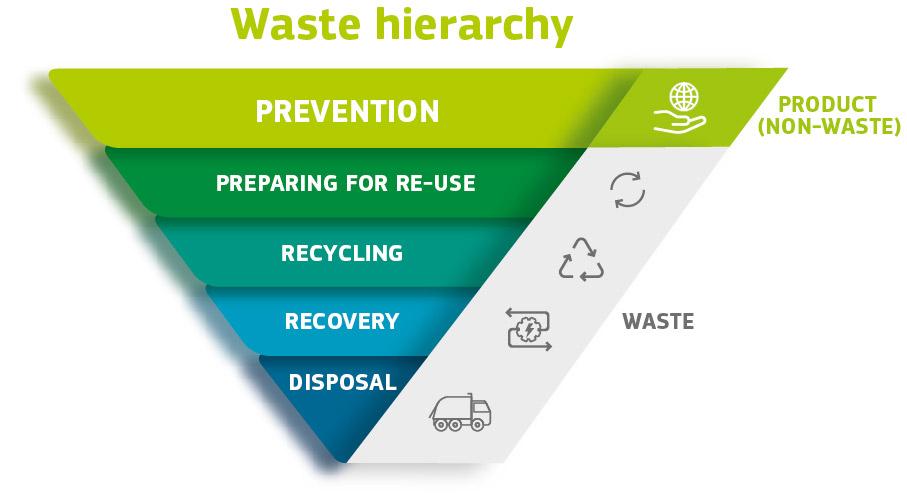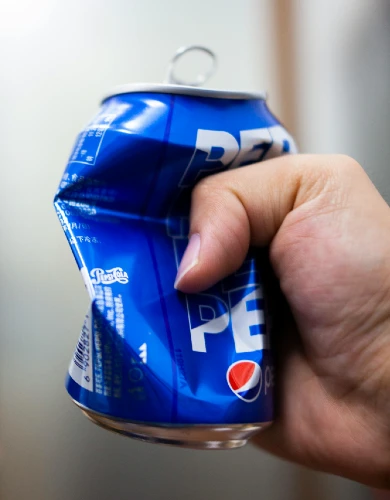The Waste Management Hierarchy
The waste hierarchy is a framework under UK law that prioritises waste management practices that minimises the environmental impact of commercial waste.
The hierarchy establishes a clear order of preference for waste management, emphasising prevention and reuse over recycling, recovery, and disposal.
This guide explains everything you need to know about the waste hierarchy, covering:
- The waste hierarchy explained
- The legal requirements of the waste hierarchy
- Waste hierarchy alternatives
- Waste hierarchy by sector
- The future of the waste hierarchy
The waste hierarchy explained
The waste hierarchy is typically represented as an inverted pyramid, highlighting the top priorities for effective waste management.
Credit: EC – Waste Framework Directive
Our experts explain each of the five steps of the waste hierarchy, including links to specific guides where we’ve provided detailed advice on implementing each step.
Prevention
Definition: Avoid waste creation at source.
Minimise waste creation at its source by making changes to business operations. Examples include designing products to use fewer materials or cancelling unwanted magazine subscriptions.
Visit our guide on waste minimisation for businesses for more examples.
Preparing for re-use
Definition: Find a secondary use for waste.
Give products or materials a second life by cleaning, repairing, or refurbishing them. Redistribute unwanted items through sale or donation to charities.
This step is particularly applicable to electronic waste and clothing waste.
Recycling
Definition: Processing materials into new products, substances, or materials for the same or different purposes.
The most common examples of recyclable waste can be processed through the following universally available waste collection services:
Other recovery
Definition: Extracting energy or materials from waste that cannot be reused or recycled.
Businesses can divert waste from landfills to recovery facilities using:
- Anaerobic digestion or composting of commercial food waste.
- Incineration of general business waste at an energy recovery facility.
Disposal
Definition: The final option when no viable alternatives exist.
Disposal involves using a general business waste service to deposit residual waste at a landfill site.
The government actively discourages this option through the landfill tax, which makes disposal more expensive than alternative recycling or recovery services.
The legal requirements of the waste hierarchy
The waste hierarchy was incorporated into UK law through the EU Waste Framework Directive in 2008, forming a guiding principle for commercial waste regulations.
The UK government has published specific advice on applying the waste hierarchy for businesses and public bodies that generate waste.
Waste hierarchy alternatives
The steps of the waste hierarchy explained above are those set out in UK law.
However, there are now two notable variants of the waste hierarchy that are commonly used. We’ll explain these in this section.
The 3 R’s
The 3 R’s is a simplified version of the waste hierarchy, commonly used as an educational tool for adults and children to promote awareness of waste management:
- Reduce: Minimise the amount of waste generated.
- Reuse: Extend the life of items by finding new uses for them.
- Recycle: Process waste materials into new products.
The ‘zero waste’ hierarchy
The zero waste hierarchy extends the traditional waste hierarchy by prioritising waste prevention and management strategies to achieve “zero waste.” This concept aligns with a fully circular economy, where minimal raw inputs are needed because resources are used perpetually, eliminating waste disposal.
The zero waste hierarchy introduces the following steps (known as the “7Rs”):
- Refuse: Avoid using or purchasing unnecessary products and packaging.
- Reduce: Minimise waste by choosing durable, long-lasting products.
- Re-use: Extend the life of products by reusing them or repurposing materials.
- Repair: Fix items instead of discarding them.
- Recycle: Process materials to create new products.
- Rot: Compost organic waste to return nutrients to the soil.
- Rethink: Innovate and design products and systems that eliminate waste.
Waste hierarchy by sector
While the general principles of the waste hierarchy apply across all sectors, certain waste types require tailored guidelines and regulations to address their unique waste management challenges.
Our waste experts have developed sector-specific waste management guidance for the largest industries in the UK. Below is a summary with links to our dedicated pages:
| Sector | Waste Type | Waste Hierarchy Differences |
|---|---|---|
| Office Waste | Stationary, cardboard, electronics, food, garden, etc. | Focus is on prevention through digital transformation, re-use of stationery and recycling |
| Industrial Waste | Manufacturing by-products | Focus on industrial symbiosis where waste from one process is used as input for another |
| Construction Waste | Construction and demolition | High emphasis on material re-use on-site, extensive recycling of concrete, bricks, metals to avoid landfills |
| Agricultural Waste | Organic waste (crop residues) | Specific focus on composting and anaerobic digestion for energy generation and soil recovery. |
| Hospital Waste | Pharmaceutical and clinical waste | Strict segregation, incineration with energy recovery, stringent disposal protocols. |
| Textile industry | Clothing and fabrics | High priority on re-use through charity and second-hand markets, and extended responsability since composite textiles are difficult to recycle. |
| Automotive Waste | End-of-life vehicles | Detailed de-pollution processes, part re-use, and material-specific recycling like metals, plastics, and batteries (black mass recycling). A significant portion is exported exported. |
| Restaurant Waste | Food waste | Specific focus on food redistribution, composting, and anaerobic digestion. |
| Oil and Gas Waste | Industry waste | Emphasis on safe disposal, metal recycling, recovery of hydrocarbons, and minimising environmental impact. |
The future of the waste hierarchy
Since the waste hierarchy was implemented into UK law in 2011, there have been significant improvements in waste management practices, leading to reduced waste generation and enhanced recycling rates.
Between 2010 and 2020, the recycling rate for commercial and industrial waste increased from 52% to nearly 70%, while the amount of waste sent to landfill decreased by approximately 65% due to the prioritisation of other waste management methods over disposal.
These successes are largely due to the waste hierarchy’s focus on promoting a more sustainable and efficient use of resources by prioritising prevention, reuse, and recycling.
Government forecasts suggest that with continued adherence to the waste hierarchy, recycling rates for commercial waste could exceed 80% by 2035.

